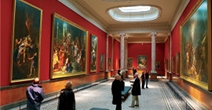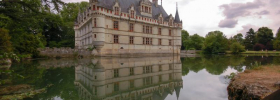 Home
Home- > Tours
- > Provence-Alpes-Côte-d'Azur
- > Bouches-du-Rhône
- > Arles
- > Discovering arles city
Discovering arles city
| Topic | Sciences and discovery |
| Departure | ARLES (13) |
| Details | The city of Arles is in the south-east of France. The arlésiennes campaigns are very wide and represent the major part of the communal territory. They are organized in four quite distinct natural units: in north, the plain of Trébon and Alpilles, in the east, Crau and in the south, the Camargue whose commune of Arles has most of the surface (with the Saintes-Maries-de-la-Mer, second vaster commune of Metropolitan France, half less wide than Arles). |
Abbay of Montmajour
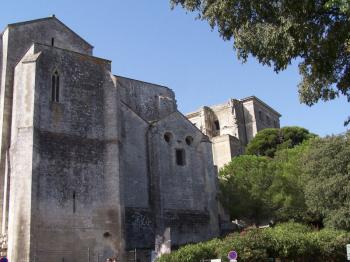
The abbey of Montmajour was built in the 12-17th centuries.
From the Latin « major» (larger), the island of Montmajour, surrounded by ponds and marshes, reaches about forty meters. It is on this site, at the doors of Arles, that the first community of Benedictines was established in 949, inaugurating eight centuries of monastic life. Gradually increased and enriched, the monastic complex quickly became one of the most visited pilgrimage centres in Europe, particularly at the time of the Great Forgiveness of the Holy-Cross, instituted in 1030. The many buildings on this site (conventual buildings, the cloister, vaults, the tower) are of great architectural interest. A new monastery, built in the 13th century, marked the site with a completely different imprint, inspired by imposing and functional civil architecture. After many historical vicissitudes, the abbey of Montmajour is today the object of various restoration projects, opening it gradually to the visitor's curiosity. In addition, it became a prestigious exhibition centre, in particular for the International Photography events.
The abbey of Montmajour presents two conventual complexes. The construction of the first lasted from the 11th to the 15th century and started with the hermitage of St Pierre made up of two vaults, of which one is troglodyte. The 12th century saw the construction of the first abbey-church, which, although unfinished, is remarkable due to its size, its simplicity and its beauty (its ribbed vault dates from the 13th century). It includes conventual buildings, the Notre-Dame church, built on a crypt which is partly underground and was added to with a cloister decorated in the Romanesque style. To the east, outside the monastery, the Holy-Cross chapel was built, evoking a monumental reliquary. In the 14th century, a bell-tower and a powerful defence tower dominated the claustral complex. Its 26 meters, offer a wide panorama which gives a better view of the original site and the complex diversity of the buildings. The monastery of Saint-Maur, which is the second conventual complex, was built in the 18th century and is the work of the architect from Avignon Pierre Mignard. Of the vast southern façade's twenty-eight windows, only four remain today.
Accommodation nearby
Amphitheatre of Arles
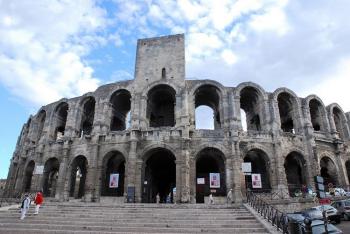
The amphitheatre is the most important Roman monument of the ancient Roman colony that can be admired today, some two millenia after its construction. Its structure was conceived of to house for large events , accommodating a large public. In their initial construction, the steps could could accommodate approximately 210 ' 000 spectators, whose access was organized by a network of gates, galleries and staircases on several floors. At the beginning of the Middle Ages it had become a closed and fortified citadel and the building was only excavated in the 19th C. It then returned, to some extent, to its original purpose, in particular with bullfighting, which has earnt it its current name of the "Arènes". It is today the city's most visited monument, carrying the image of Arles around the world.
With a large axis which is 136 metres long and a small axis which is 107 metres long, the Arles amphitheatre is slightly larger than that of Nimes and occupies the twentieth rank in the Roman world. It has the shape of an ellipsis.
The façade comprises two levels of sixty arches in a semicircular arch, separated by massive rectangular abutments. A larger opening emphasized the ends of the building's two axes. The main entrance was not to the north as it is today, but to the west side where the remains of a flight of stairs up to the city can be seen today. The cavea, the place reserved for the spectators, comprises 34 steps, divided into four sections or maeniana, where the spectators were divided according to their social status. The building's original capacity is considered to have been for some 21,000 people. To allow visitors to reach the steps, an ingenious system of circular galeries had been designed, with horizontal passages, and alternating staircases. On the ground floor, the outside gallery is particularly remarkable, due to its roof of large monolith tiles. It gave access to an interior vaulted gallery in a semicircular arch, which opened onto the first maenianum and the lower part of the second.
Accommodation nearby
Interpretation's center of the nature La Capelière

Located on the edge of the Vaccarès, La Capelière, the administrative center for the Camargue Reserve, was opened in 1979 in an old Carmargue farmhouse surrounded by the marsh. Here you will find a nature information center, a "nature" shop, a permanent exhibition on the Camargue Reserve, a projection room, 1.5 km of natural path equipped with panels describing the various landscapes of the Camargue (forest, lawn, sansouire and reed-bed), an archeological site, 4 observatories on the marshes, and 2 panoramic platforms looking out onto the Vaccarès.
Accommodation nearby
Roman circus of Arles
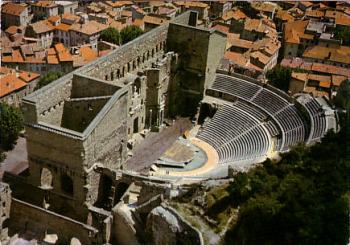
Built en 149.
Being the largest Roman building, the circus, could only find its place outside the city. In the 3rd century it was built to the south-west of the city, on the edge of the Rhone. It was used primarily for chariot and horse-races, but also sometimes for cavalry combats and venatios, a kind of hunting using hounds. Its construction must not have been easy. Taking into account the unstable nature of the ground, it had to be built on thousands of wooden piles. Of its materials and decorations, scattered at the end of the Roman Empire, only a few pieces remain. Some have been reused, others are exhibited in the Museum of Arles and Ancient Provence. Its most sumptuous ornament is however extremely famous: it is the obelisk installed in front of the Town Hall in the 17th century.
The Arles Circus was 450 meters long and 101 meters wide. It included steps which could accommodate 20 ' 000 spectators, and a vast packed arena equipped with a long central separation, the spina (the spine). Decorated with sculptures and basins, this was marked off at its two ends by boundaries (or metae) that the competitors endeavoured to be the first to pass. The track was surrounded by a wall (the podium), high enough to protect the spectators. The steps rested on a modular architectural structure of rooms closed off by slanted vaults, rather similar to that of an amphitheatre. Because of the instability of the clay soil, complicated foundations were needed. They were made out of 30 ' 000 piles of wood 2 to 3m50 in length. Today, only the remains of the substructure of the cavea (steps) and the outside of the spendone, (the round part the circus) remain visible.
Accommodation nearby
Space Van Gogh
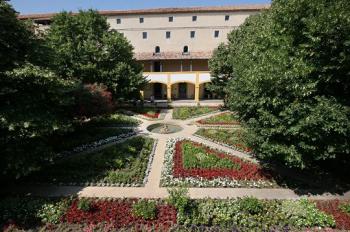
Built in the 16th and 17th centuries, the hospital's vast quadrilateral falls under a double context: a period of prosperity and modernization in the city on the one hand and a firmly established local hospital tradition on the other. In 1835, three wings were built in order to open new rooms, following a very serious cholera epidemic. At the end of the 19th century the hospital received, a remarkable visitor: Vincent Van Gogh, who represented the building in several of his paintings. The establishment ran until the years 1970-1980. At this date, the unused hospital became the object of a vast restoration programme to turn it into an important cultural and university center. For this, excavations were made which uncovered remains in the site's basement which dated back to protohistory and which were of great importance in understanding the city.
The buildings form a quadrilateral which frames a garden. The ground floor opens onto the outside through arcades which border a circulation gallery, which is also present on the second floor. The façades are severe, with small openings, according to the model of the hospitals of the time: hospitals were closed places which should not transmit dangerous «miasmas » outside. The building was overhung by garret with farmhouse beams (a combination of parts intended to carry the ridge of the roofing) and tie-beams (horizontal beams which maintain the beams oblique to the sides of the roof). The ground floor of the western building housed the administration services: the kitchen equipped with an immense chimney, the wash-house, the linen room, and other utility buildings. The hospital's main entrance was on the current Rue Dulau.
Rebuilt in 1587 by Antoine Pons, the solid wood door was made out of pitch pine (a mixture of pine species from North America). It is framed by two grooved and surmounted doric columns with a triangular pediment. Above, an inscription commemorates the date of construction of the building. This portal is a Classified Historic building.
Accommodation nearby
The towers of Arles

- Tower of la Cavalerie
The Cavalry gate raises its two round towers at the northern entrance of the old city centre. Its name points to the establishment, in the Middle Ages and in this district, of the Order of the Temple.
From the 13th century, after the construction of new districts including that of Bourg-Neuf (the present day Cavalry district), the city's perimeter, which would remain almost unchanged until the 19th century, was entirely surrounded by ramparts.
Beyond the door, the fields and the pasture land began, occupied today by the Lamartine square and the station area (19th century), and later, by the city's northern districts.
- Tower of Mourgues
It is from the interior that one can best appreciate the quality of the tower's construction. With an internal diameter of 7.90 meters, it opened on to the city by a door whose lintel, a monolith shaped around the curve of the façade, is surmounted by a perfectly fitted relieving arch. Moreover, this postern shows that the ground level was the same inside as outside the city. Currently, the height of 6 meters, the tower is built with the same care as the two perpendicular curtain walls on which it support's itself. Initially circular, the Tower of Mourgues has undergone a certain numbers of changes. On its northern side, the tower was lined on the outside by a facing reusing large brickwork, no doubt during late Antiquity. The southern part was also reinforced, probably in 16th century, by a polygonal sheathing in average regular medium brickwork with glaze base, with a ramp with cut sides. West of the tower, towards the Vauban rise, the wall was lined on the outside by a facing of large brickwork, starting the medieval rampart.
- Tower of clock
Today, if the clock tower appears to be an integral part of the town hall, there is, in fact, more than a century separating the construction of the two buildings. Indeed, it was built in the middle of the 16th century to replace an older tower. In a particularly prosperous period in the history of Arles, it came at the initiative of the consuls, who wanted to display their power.
Thus, the tower commands the heart of the city, next to the common house of municipal officials, and opposite the bell-tower of the St Trophime cathedral, itself a symbol of religious power. Its architecture is characteristic of the Renaissance and is mainly inspired by Antiquity, which became an important source of inspiration and curiosity in the city at that time.
The architectural structure of the clock tower and its decoration, inspired by antiquity, imitate the Roman mausoleum of the Ancients in Saint-Rémy-de-Provence. The entablatures with carved friezes, grooved columns, ionic and Corinthian capitals are particularly fine. Four clocks, of which only one remains, were installed in the upper part of the tower. Inside there were several bells (one large and two small) were which rung for the important occasions in the city's life, in particular in the event of an emergency. The clocks' extremely sophisticated mechanism occupied most of the space. One bell sounded the hour. This one was recast several times; it was given the name of the new consul each time. On top, the rotunda is surmounted by "the bronze man"; a statue of the god Mars, another evocation of Antiquity. Laurent Vincent, a founder from Avignon, made it in 1555. It is said that it was made with the bronze from the guns that Charles V's army had given up at the time of its incursion in 1536. During the Revolution, "the bronze man" escaped being dismounted and molten to make weapons. The consuls wanted to conserve the tower, and to integrate it into the construction of the town hall. The adopted solution was one of the contributions which Jules Hardouin Mansart brought to the project.
Accommodation nearby
Dicover the Unesco world heritage monuments
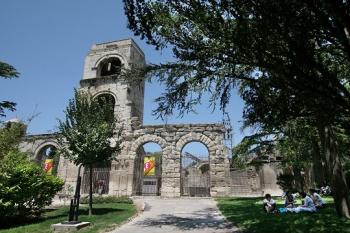
Arles is noted for the wealth of its Roman and Romanesque heritage. The monuments of the city listed as Unesco world heritage monuments in 1981 include the Roman amphitheatre (the arena), the Roman theatre, the Cryptoportico (foundations of the Roman Forum), the Roman baths of Constantine, the remains of the Roman circus, the cloister and portal of St. Trophime’s, and the Alyscamp cemetery.
This cemetery was the departure point for the « Chemin d’Arles », also known as the Via Tolosana, one of the three medieval pilgrimage routes across France leading to Santiago de Compostela in Spain. Along with these monuments, Arles has also preserved many lovely buildings dating from the 16th, 17th and 18th centuries. Since 1986, the city has joined the French network organization known as « Villes d’art et d’histoire », guaranteeing quality cultural service
Arles has three remarkable museums :
- The Departmental Museum antique Arles, the Arles archeological museum, anchored since 1995 on the banks of the Rhone River, was built by Henri Ciriani beside the remains of the Roman circus. It contains the archeological collections of the city and the surrounding region , spanning the period from neolithic times to the end of the Roman and early Christian era.
- The Museon Arlaten, the local ethnographical museum, is housed in the former Laval-Castellane town house dating from the 15th century. The museum was created in 1896 by Frederic Mistral, a regionalist poet, and exhibits costumes, furniture, tools, objects connected with local religious traditions and superstitions, illustrating life in Provence during the 19th century.
- The Musée Réattu, Donation Picasso, the fine arts museum, is housed in the former Grand Priory of the Knights of Malta. It exposes the works of Jacques Réattu, an Arlesian painter of the period of the French Revolution, 18th and 19th centuries, as well as modern and contemporary artists (Picasso, Zadkine and Alechinsky). The museum also possesses a remarkable photography collection (Henri-Cartier, Bresson, Edward Weston . . .)
Accommodation nearby
Discover the pays of Arles

Around the Roman and Romanesque city of Arles, with its architectural treasures tnat fascinate visitors from all over the world, are three different types of landscapes :
- The Camargue, situated between the two branches of the Rhone River, is one of the loveliest natural settings in Europe. Its fauna and flora are protected within the Camargue Regional Nature Park (Parc Naturel Régional de Camargue).
- The chain of hills called the Alpilles, land of vineyards and olive groves, inspired Frédéric Mistral.
- The Crau, an arid rocky plateau, is inhabited by an extraordinary number of birds.
Accommodation nearby
Arles, the heart of the Provence

Arles is a strategic spot within a circle of varied landscapes, at the heart of the Provence Alpes Côte d'Azur Region, in the department called Bouches du Rhône. It is the gateway to the Camargue, one of the nicest natural sites en Europe with an exceptionally rich plant and animal life. The Alpilles, dominated by the town of Baux-de-Provence, stretch 25 kilometers to the northeast. These limestone hills are surrounded by sunny pleasant Provençal villages spread out among vineyards and olive orchards : Fontvieille, Paradou, Maussane, Saint-Rémy…
On the border between Provence and Languedoc, your stay in Arles will bring you close to Tarascon and Beaucaire, the Saintes-Maries de la Mer, Aix en Provence the city of Cézanne and the Montagne Sainte-Victoire, Martigues and the Blue Coast, Marseille, the Greek city, the cliffs of Cassis, Aubagne the city of Marcel Pagnol and the Ste. Baume, Nîmes and the Pont-du-Gard, d’Avignon and the Papal Palace, Salon de Provence, the city where Nostradamus lived and is buried is also home to the French Air Force acrobatic flying team.
Accommodation nearby
Latest news on : Discovering Arles city
Tourism near
 Visit the city of Arles
Visit the city of Arles - 7 Museum
- 14 Monuments
Tours
 Tour to explore Marseille
Tour to explore Marseille
 In the footsteps of Marcel Pagnol
In the footsteps of Marcel Pagnol
 Tour de Provence (cycling tour)
Tour de Provence (cycling tour)
 Fontvieille
Fontvieille






















